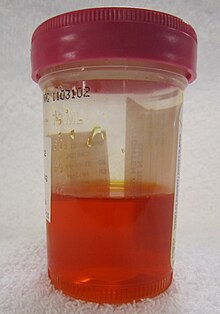Phenazopyridine
 | |
| Clinical data | |
|---|---|
| Trade names | Pyridium |
| AHFS/Drugs.com | Monograph |
| MedlinePlus | a682231 |
| License data | |
| Routes of administration | By mouth |
| ATC code | |
| Legal status | |
| Legal status |
|
| Identifiers | |
| |
ECHA InfoCard | 100.002.149 |
| Chemical and physical data | |
| Formula | C11H11N5 |
| Molar mass | 213.244 g·mol−1 |
| | |
Phenazopyridine is a
In 2021, it was the 285th most commonly prescribed medication in the United States, with more than 700,000 prescriptions.[1][2]
Medical uses
Phenazopyridine is prescribed for its local analgesic effects on the urinary tract. It is sometimes used in conjunction with an antibiotic or other anti-infective medication at the beginning of treatment to help provide immediate symptomatic relief. Phenazopyridine does not treat infections or injury; it is only used for symptom relief.[3][4] It is recommended that it be used for no longer than the first two days of antibacterial treatment as longer treatment may mask symptoms.[4]
Phenazopyridine is also prescribed for other cases requiring relief from irritation or discomfort during urination. For example, it is often prescribed after the use of an in-dwelling
This medication is not used to treat infection and may mask symptoms of inappropriately treated UTI. It provides symptom relief during a UTI, following surgery, or injury to the urinary tract. UTI therapy should be limited to 1–2 days.[4] Long-term use of phenazopyridine can mask symptoms.[5]
Side effects

Phenazopyridine produces a vivid color change in urine, typically to a dark orange to reddish color. This effect is common and harmless, and indeed a key indicator of the presence of the medication in the body. Users of phenazopyridine are warned not to wear contact lenses, as phenazopyridine has been known to permanently discolor contact lenses and fabrics.[3][6] It also tends to leave an orange-yellow stain on surfaces it comes in contact with. Some may be mistakenly concerned that this indicated blood in the urine.
Phenazopyridine can also cause
Phenazopyridine should be avoided by people with
Phenazopyridine is an azo dye.[17][18] Other azo dyes, which were previously used in textiles, printing, and plastic manufacturing, have been implicated as carcinogens that can cause bladder cancer.[19] While phenazopyridine has never been shown to cause cancer in humans, evidence from animal models suggests that it is potentially carcinogenic.[4][20]
Pregnancy
This medication has shown no adverse events in animal models, but no human trials have been conducted.[4] It is not known if phenazopyridine is excreted in breast milk.[4]
Pharmacokinetics
The full
Mechanism of action
Phenazopyridine's
Brand names
In addition to its generic form, phenazopyridine is distributed under the following brand names:
- Azo-Maximum Strength
- Azo-Standard
- Baridium
- Nefrecil
- Phenazalgin
- Phenazo
- Phenazodine
- Pyridiate
- Pyridium
- Pyridium Plus
- Sedural
- Uricalm
- Uristat
- Uropyrine
- Urodine
- Urogesic
- Urovit
References
- ^ "The Top 300 of 2021". ClinCalc. Archived from the original on 15 January 2024. Retrieved 14 January 2024.
- ^ "Phenazopyridine - Drug Usage Statistics". ClinCalc. Retrieved 14 January 2024.
- ^ a b c d "Pyridium Plus Tablets" (PDF). Warner Chilcott. Archived from the original (PDF) on 20 April 2014. Retrieved 15 June 2019.
- ^ a b c d e f g h i j k "PYRIDIUM (phenazopyridine) tablet, film coated". DailyMed. Archived from the original on 21 April 2014. Retrieved 15 June 2019.
- PMID 5776230.
- ^ "Phenazopyridine: MedlinePlus Drug Information". Medline plus. American Society of Health-System Pharmacists, Inc. Retrieved 15 June 2019.
- S2CID 41928972.
- PMID 6410650.
- S2CID 7262697.
- S2CID 27340450.
- PMID 16225031. Archived from the originalon 28 August 2021. Retrieved 6 July 2009.
- S2CID 20968675.
- PMID 6620333.
- PMID 1892154.
- PMID 19300288.
- S2CID 22812461.
- ^ Cystitis in Females~treatment at eMedicine
- ^ "Phenazopyridine Hydrochloride". The American Society of Health-System Pharmacists. Retrieved 30 June 2015.
- ^ Transitional Cell Carcinoma Imaging at eMedicine
- ^ "Phenazopyridine Hydrochloride" (PDF). Report on Carcinogens, Twelfth Edition (2011). National Toxicology Program. Archived from the original (PDF) on 17 February 2013. Retrieved 15 June 2019.
- ^ PMID 2352143.
- ^ S2CID 29419875.
